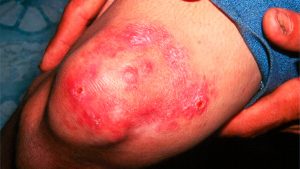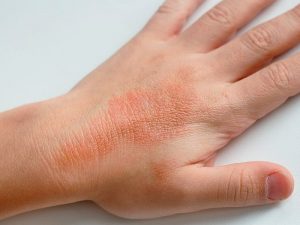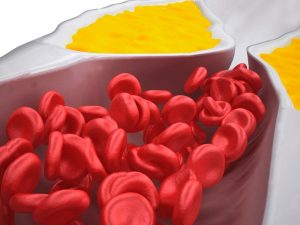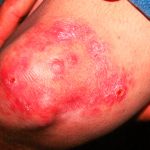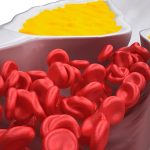What is Arthritic Psoriasis?
The word ‘psoriasis’ often conjures up images of itchy skin rashes and endless ointment treatments. This uncomfortable autoimmune skin disease appears in 1-3 per cent of the population, according to studies by the European League Against Rheumatism (EULAR).
Psoriasis is characterized by raised, red and scaly patches, most often around the elbow, knees or scalp. It is important to monitor psoriasis, because it can go beyond skin-deep. About 30 per cent of those afflicted are at risk of developing psoriatic arthritis (PsA), another form of the autoimmune disease. The autoimmune classification of diseases occurs when the body’s healthy tissue is attacked by the immune system, causing inflammation.
PsA, unlike psoriasis, is inflammation of the joints. Symptoms of the disease can be swelling, stiffness, joint pain and fatigue. PsA commonly manifests between the ages of 30 and 50. However, diagnose for pediatric onset is between 11 and 12.
A study shows that as many as 50% of PsA patients have a family history of the disease that includes one, sometimes multiple, cases. If you have a psoriasis and a family history of PsA, let your doctor know, however PsA can still occur without initial psoriasis. PsA undetected and untreated can lead to permanent joint damage.
Types of Psoriatic Arthritis
Not all types of PsA are severe. Milder psoriatic arthritis is sometimes referred to as oligoarticular. This type affects four or fewer joints in the body. The more severe PsA classification is commonly known as polyarticular, and affects four or more joints.
There are five types of psoriatic arthritis:
Symmetric psoriatic arthritis: About 50 per cent of of all PsA cases fall under the symmetric category. This is distinguished by joint pain on both sides of the body. Symmetric PsA is similar to rheumatoid arthritis.
Asymmetric psoriatic arthritis: This form of PsA falls under oligoarticular, as it is a milder pain. Asymmetric PsA makes up 35 per cent of condition cases.
Distal psoriatic arthritis: You will notice distal PsA from symptoms in your toes and fingers. Inflammation causes stiffness near the tips of the appendages. Noticeable indicators of distal PsA are splitting of nails or toenails, white spots and nails lifting off the nailbed.
Spondylitis: Concentration of this type of PsA is in the spine and neck, with symptoms of pain and stiffness.
Arthritis mutilans: Falling at the farthest end of the polyarticular scale, arthritis mutilans affects the smallest number, with only 5 per cent of people afflicted. Like distal psoriatic arthritis, is it targets the fingers and toes, but causes deformities in the joints that can destroy them altogether.
Possible Side-Affects of PsA
People with PsA are more likely to develop:
- High blood pressure
- High cholesterol
- Obesity
- Diabetes
Treatments for Psoriasis
- Nonsteroidal Anti-Inflammatory Drugs (NSAIDs) :NSAIDs include prescription and non-prescription drugs, such as aspirin and ibuprofen. Mostly consumed orally, these drugs are used to aid in controlling swelling pain and stiffness. As with any drug, discussing side effects with your doctor is important. Some NSAIDs can cause stomach problems, such as ulcers, when taken over long periods of time and even increased risk of heart attacks or strokes.
- Disease-Modifying Antirheumatic Drugs (DMARDs) : Disease-modifying antirheumatic drugs (DMARDs) are used to not only relieve severe symptoms of PsA, but can be used to slow joint/tissue damage. There are a variety of DMARDs. Talk to your doctor about choosing the right one.
- Biologics: Biologic drugs are the next step for PsA patients who have not responded to other treatments. Biologics are are administered through injections or infusions. These medications are used to slow or stop joint damage.
- New Oral Treatments: New oral treatments improve symptoms of psoriatic arthritis by inhibiting specific molecules associated with inflammation. Unlike biologics, which are derived from living sources and must be administered via injection or infusion, these treatments can be effectively delivered as tablets taken by mouth.
- Read about new oral treatments
- Light therap : Light therapy can be used as a treatment for both psoriasis and PsA. The process involves regular exposure to ultraviolet light, with the help of a medical professional.
- Corticosteroids: These are orally administered drugs, created to mimic a anti-inflammatory hormone called cortisol. They reduce inflammation, but can result it in undesirable side affects such as facial swelling, weight gain and osteoporosis.
- Topical treatments: You may have seen ads on TV for topical medicines. These ointments are applied directly to psoriasis rashes. Treatments come in a variety of topical forms such as creams, gels, lotions, shampoos, sprays or ointments. Your doctor can prescribe you topicals that contain corticosteroids. However, OCT products can still provide decent results if they contain salicylic acid.


